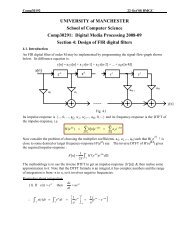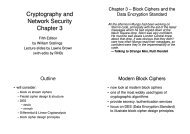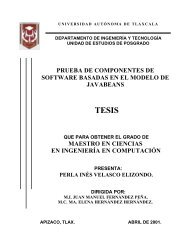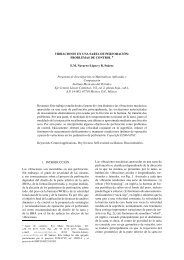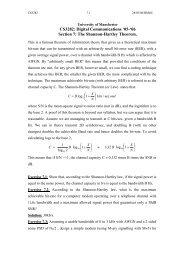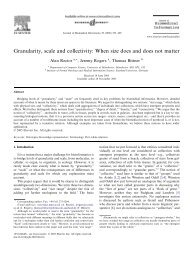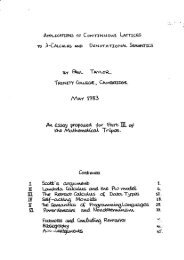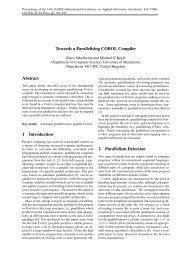Data Authentication Algorithm
Data Authentication Algorithm
Data Authentication Algorithm
Create successful ePaper yourself
Turn your PDF publications into a flip-book with our unique Google optimized e-Paper software.
Cryptography and<br />
Network Security<br />
Chapter 12<br />
Fifth Edition<br />
by William Stallings<br />
Lecture slides by Lawrie Brown<br />
(with edits by RHB)<br />
Outline<br />
• will consider:<br />
– message authentication requirements<br />
– message authentication using encryption<br />
– MACs<br />
– HMAC authentication using a hash function<br />
– CMAC authentication using a block cipher<br />
– Pseudorandom Number Generation (PRNG)<br />
using Hash Functions and MACs<br />
Chapter 12 – Message<br />
<strong>Authentication</strong> Codes<br />
• At cats' green on the Sunday he took the message from<br />
the inside of the pillar and added Peter Moran's name to<br />
the two names already printed there in the "Brontosaur"<br />
code. The message now read: “Leviathan Leviathan to Dragon:<br />
Martin Hillman, Trevor Allan, Peter Moran: observe and<br />
tail.” tail. What was the good of it John hardly knew. He felt<br />
better, he felt that at last he had made an attack on Peter<br />
Moran instead of waiting passively and effecting no<br />
retaliation. Besides, what was the use of being in<br />
possession of the key to the codes if he never took<br />
advantage of it?<br />
• —Talking Talking to Strange Men, Ruth Rendell<br />
Message <strong>Authentication</strong><br />
• message authentication is concerned with:<br />
– protecting the integrity of a message<br />
– validating identity of originator<br />
– non-repudiation non repudiation of origin (dispute resolution)<br />
• will consider the security requirements<br />
• then three alternative functions used:<br />
– hash function (see Ch 11)<br />
– message encryption<br />
– message authentication code (MAC)
Message Security Requirements<br />
• disclosure<br />
• traffic analysis<br />
• masquerade<br />
• content modification<br />
• sequence modification<br />
• timing modification<br />
• source repudiation<br />
• destination repudiation<br />
• extra problem if plaintext can be any bitpattern<br />
Public-Key Public Key Message Encryption<br />
• if public-key public key encryption is used:<br />
– encryption provides no confidence of sender<br />
• since anyone potentially knows public-key public key<br />
– however if<br />
• sender signs message using their private key<br />
• then encrypts with recipients public key<br />
• then have both secrecy and authentication<br />
– again need to recognize corrupted messages<br />
– but at cost of two public-key public key uses on message<br />
Symmetric Message Encryption<br />
• encryption can also provides authentication<br />
• if symmetric encryption is used then:<br />
– receiver knows sender must have created it<br />
– since only sender and receiver know key used<br />
– know content cannot have been altered<br />
– if message has suitable structure, redundancy<br />
or a checksum to detect any changes<br />
Message <strong>Authentication</strong> Code<br />
(MAC)<br />
• generated by an algorithm that creates a<br />
small fixed-sized fixed sized block<br />
– depending on both message and some key<br />
– like encryption, but need not be reversible<br />
• appended to message as a signature<br />
• receiver performs same computation on<br />
message and checks it matches the MAC<br />
• provides assurance that message is<br />
unaltered and comes from sender
Message <strong>Authentication</strong> Code<br />
• a small fixed-sized fixed sized block of data<br />
• generated from message + secret key<br />
• MAC= MAC C(K,M)<br />
• appended to message when sent<br />
Message <strong>Authentication</strong> Codes<br />
• as shown the MAC provides authentication<br />
• can also use encryption for secrecy<br />
– generally use separate keys for each<br />
– can compute MAC either before or after encryption<br />
– is generally regarded as better done before<br />
• why use a MAC?<br />
– sometimes only authentication is needed<br />
– sometimes need authentication to persist longer than<br />
the encryption (eg ( eg. . archival use)<br />
– protection for arbitrary bitpattern plaintexts<br />
• note that a MAC is not a digital signature<br />
(repudiation problem)<br />
Uses of MAC MAC Properties<br />
• a MAC is a cryptographic checksum<br />
MAC=C MAC K(M) (M)<br />
– condenses a variable-length variable length message M<br />
– using a secret key K<br />
– to a fixed-sized fixed sized authenticator<br />
• is a many-to many to-one one function<br />
– potentially many messages have same MAC<br />
– but finding these needs to be very difficult
Requirements for MACs<br />
• taking into account the types of attacks<br />
• need the MAC to satisfy the following:<br />
1. knowing a message and MAC, is infeasible<br />
to find another message with same MAC<br />
2. MACs should be uniformly distributed<br />
3. MAC should depend equally on all bits of the<br />
message<br />
Security of MACs<br />
• cryptanalytic attacks exploit structure<br />
– like block ciphers want brute-force brute force attacks to<br />
be the best alternative<br />
• more variety of MACs so harder to<br />
generalize about cryptanalysis<br />
Security of MACs<br />
• like block ciphers have:<br />
• brute-force brute force attacks exploiting<br />
– strong collision resistance hash have cost 2 m / 2<br />
• 128-bit 128 bit hash looks vulnerable, 160-bits 160 bits better<br />
– MACs with known message-MAC message MAC pairs<br />
• can either attack keyspace (cf cf key search) or MAC<br />
• at least 128-bit 128 bit MAC is needed for security<br />
Keyed Hash Functions as MACs<br />
• want a MAC based on a hash function<br />
– because hash functions are generally faster<br />
– crypto hash function code is widely available<br />
• hash includes a key along with message<br />
• original proposal:<br />
KeyedHash= KeyedHash Hash(Key|Message) Hash(Key|Message)<br />
– some weaknesses were found with this<br />
• eventually led to development of HMAC
HMAC Design Objectives<br />
• use, without modifications, hash functions<br />
• allow for easy replaceability of embedded<br />
hash function<br />
• preserve original performance of hash<br />
function without significant degradation<br />
• use and handle keys in a simple way.<br />
• have well understood cryptographic analysis<br />
of authentication mechanism strength<br />
ipad = (00110110)*<br />
HMAC<br />
Overview<br />
opad = (01011100)*<br />
HMAC<br />
• specified as Internet standard RFC2104<br />
• uses hash function on the message:<br />
HMAC K(M) (M)= Hash[(K + XOR opad) opad ||<br />
Hash[(K + XOR ipad) ipad || M)]] M)]<br />
– where K + is the key, zero-padded zero padded out to size<br />
– opad, opad,<br />
ipad are specified padding constants (50%<br />
bits in common), repeated to pad out to size<br />
• overhead is just 3 more hash calculations than<br />
the message needs alone<br />
• any hash function can be used<br />
– eg. MD5, SHA-1, SHA 1, RIPEMD-160, RIPEMD 160, Whirlpool<br />
HMAC<br />
Precom-<br />
putation
HMAC Security<br />
• proved security of HMAC relates to that of<br />
the underlying hash algorithm<br />
• attacking HMAC requires either:<br />
– brute force attack on key used<br />
– birthday attack (but since keyed, would need<br />
to observe a very large number of messages)<br />
• choose hash function used based on<br />
speed versus security constraints<br />
<strong>Data</strong> <strong>Authentication</strong> <strong>Algorithm</strong><br />
N.B. DAA K(X) (X) = DAA K(X (X || (X XOR DAA K(X))) (X)))<br />
Using Symmetric Ciphers for MACs<br />
• can use any block cipher chaining mode<br />
and use final block as a MAC<br />
• <strong>Data</strong> <strong>Authentication</strong> <strong>Algorithm</strong> (DAA) is<br />
a widely used MAC based on DES-CBC DES CBC<br />
– using IV=0 and zero-pad zero pad of final block<br />
– encrypt message using DES in CBC mode<br />
– and send just the final block as the MAC<br />
• or the leftmost M bits (16≤M≤64) (16 64) of final block<br />
• but final MAC is now too small for security<br />
CMAC<br />
• previously saw the DAA (CBC-MAC) (CBC MAC)<br />
• widely used in government and industry<br />
• but has message size limitation<br />
• can overcome using 2 keys and padding<br />
• thus forming the Cipher-based Cipher based Message<br />
<strong>Authentication</strong> Code (CMAC)<br />
• adopted by NIST SP800-38B SP800 38B
CMAC Overview<br />
Counter with Cipher Block<br />
Chaining-Message<br />
Chaining Message<br />
<strong>Authentication</strong> Code (CCM)<br />
K 1 = L•x<br />
L = E (K,0 n )<br />
K 2 = L•x 2<br />
• NIST standard SP 800-38C 800 38C for WiFi<br />
• variation of encrypt-and encrypt and-MAC MAC approach<br />
• algorithmic ingredients<br />
– AES encryption algorithm<br />
– CTR mode of operation<br />
– CMAC authentication algorithm<br />
• single key used for both encryption & MAC<br />
Authenticated Encryption<br />
• simultaneously protect confidentiality and<br />
authenticity of communications<br />
– often required but usually separate<br />
• approaches<br />
– Hash-then Hash then-encrypt: encrypt: E(K, (M || H(M))<br />
– MAC-then MAC then-encrypt: encrypt: E(K2, (M || MAC(K1, M))<br />
– Encrypt-then<br />
Encrypt then-MAC: MAC: (C=E(K2, M), T=MAC(K1, C)<br />
– Encrypt-and Encrypt and-MAC: MAC: (C=E(K2, M), T=MAC(K1, M)<br />
• decryption / verification straightforward<br />
• vulnerabilities with all, without good design<br />
CCM<br />
Operation
Galois/Counter Mode (GCM)<br />
• NIST standard SP 800-38D, 800 38D, parallelizable<br />
• message is encrypted in variant of CTR<br />
• ciphertext multiplied with key H and length<br />
over GF(2 128 ) to generate authenticator<br />
• have GMAC MAC-only MAC only mode also<br />
• uses two functions:<br />
– GHASH - a keyed hash function<br />
– GCTR - CTR mode with incremented counter<br />
GCM<br />
Mode<br />
Overview<br />
GCM Functions GCM Functions
Pseudorandom Number<br />
Generation (PRNG) Using Hash<br />
Functions and MACs<br />
• essential elements of PRNG are<br />
– seed value<br />
– deterministic algorithm<br />
• seed must be known only as needed<br />
• can base PRNG on<br />
– encryption algorithm (Chs ( Chs 7 & 10)<br />
– hash function (ISO18031 & NIST SP 800-90) 800 90)<br />
– MAC (NIST SP 800-90) 800 90)<br />
PRNG using a MAC<br />
• MAC PRNGs in<br />
SP800-90, SP800 90,<br />
IEEE 802.11i,<br />
TLS<br />
– use key<br />
– input based on<br />
last hash in<br />
various ways<br />
PRNG using a Hash Function<br />
• hash PRNG from<br />
SP800-90 SP800 90 and<br />
ISO18031<br />
– take seed V<br />
– repeatedly add 1<br />
– hash V<br />
– use n-bits n bits of hash<br />
as random value<br />
• secure if good<br />
hash used



